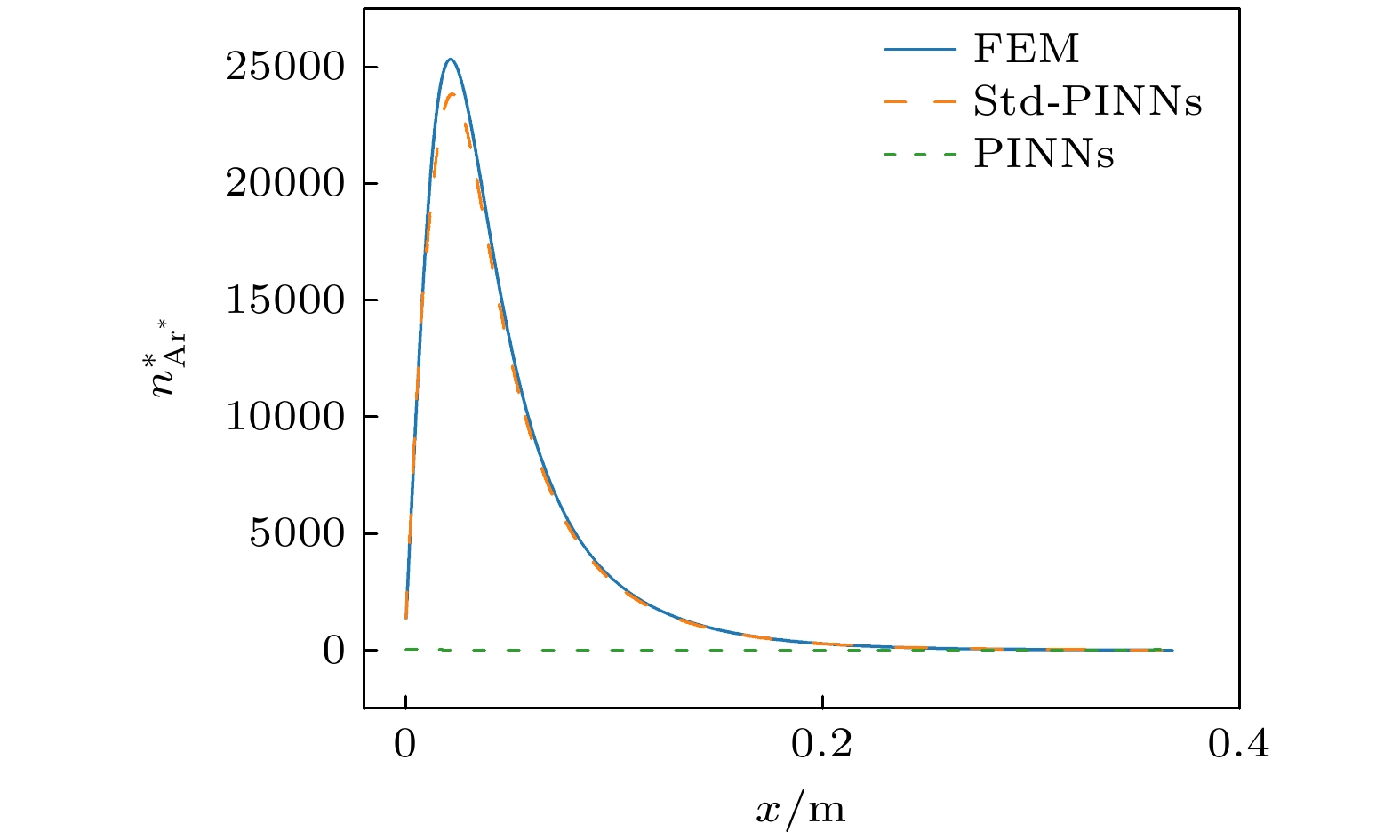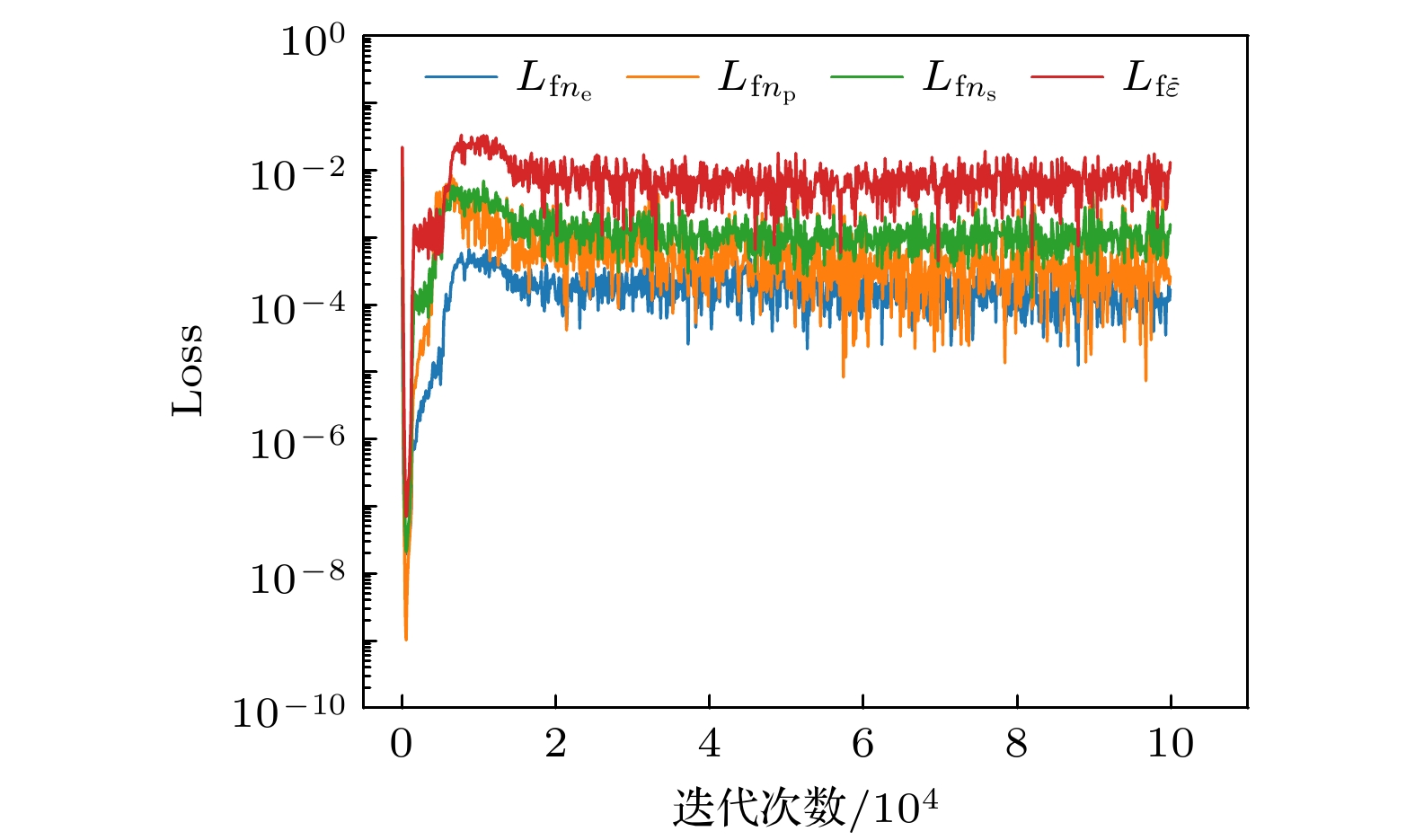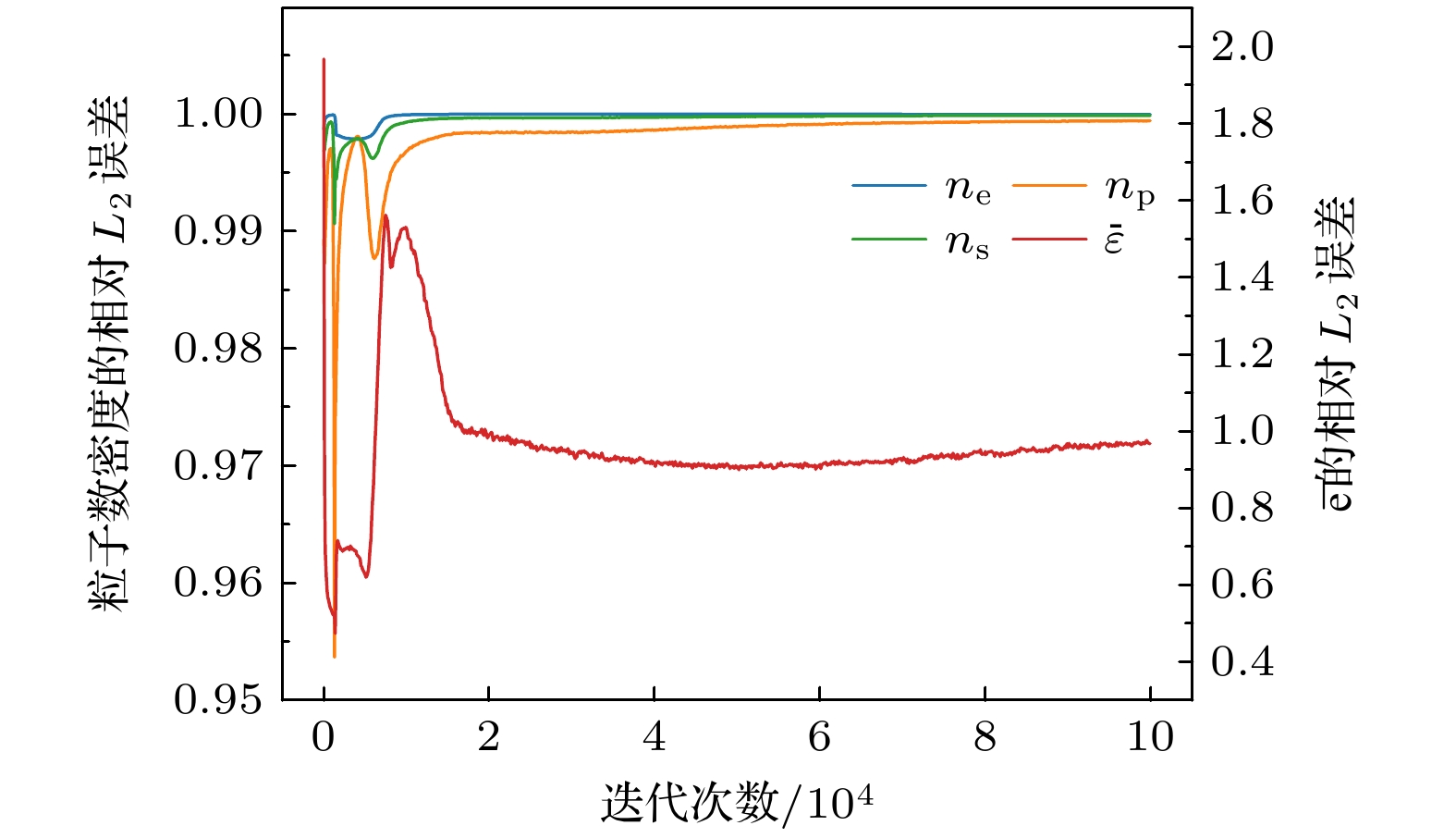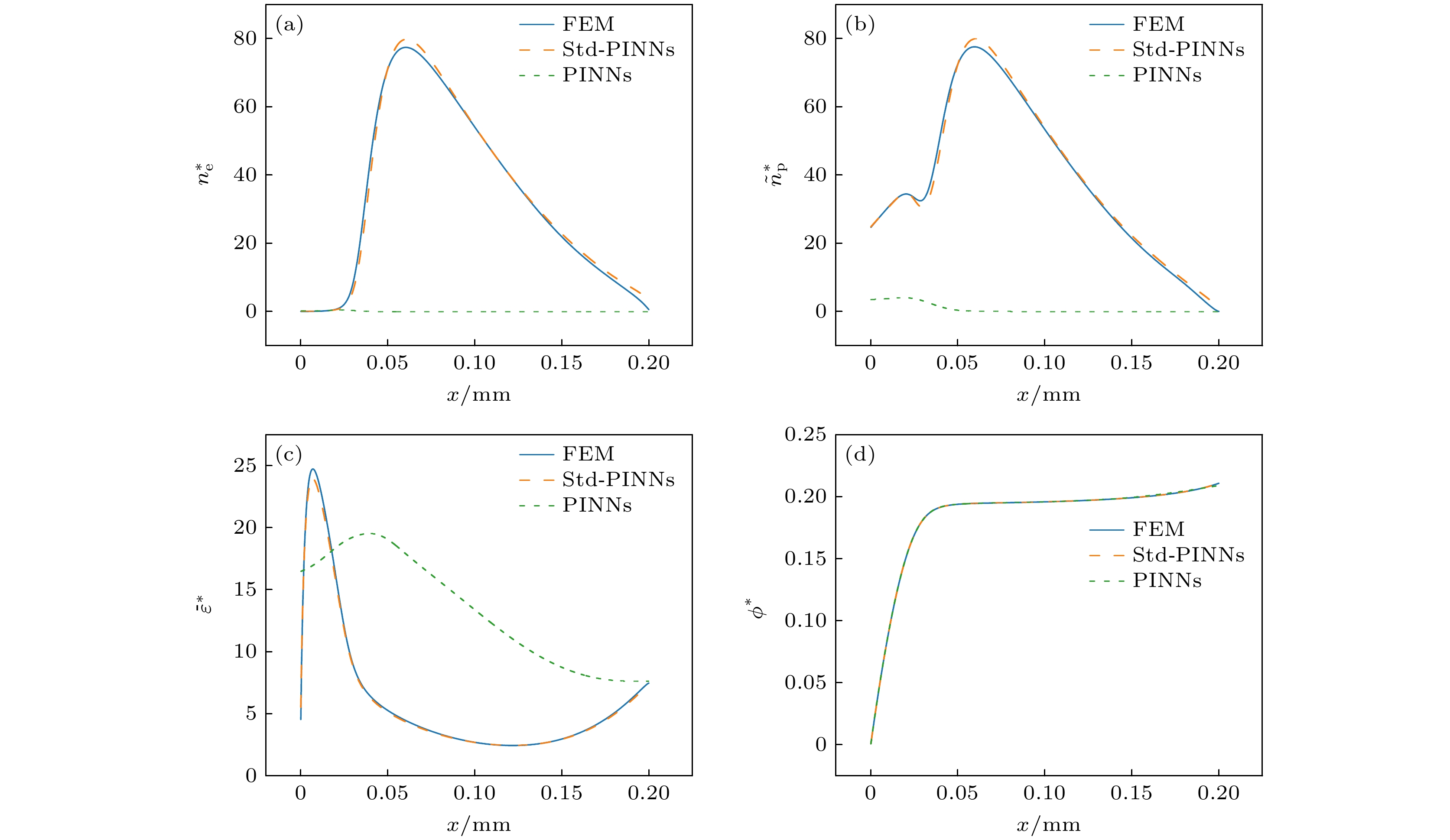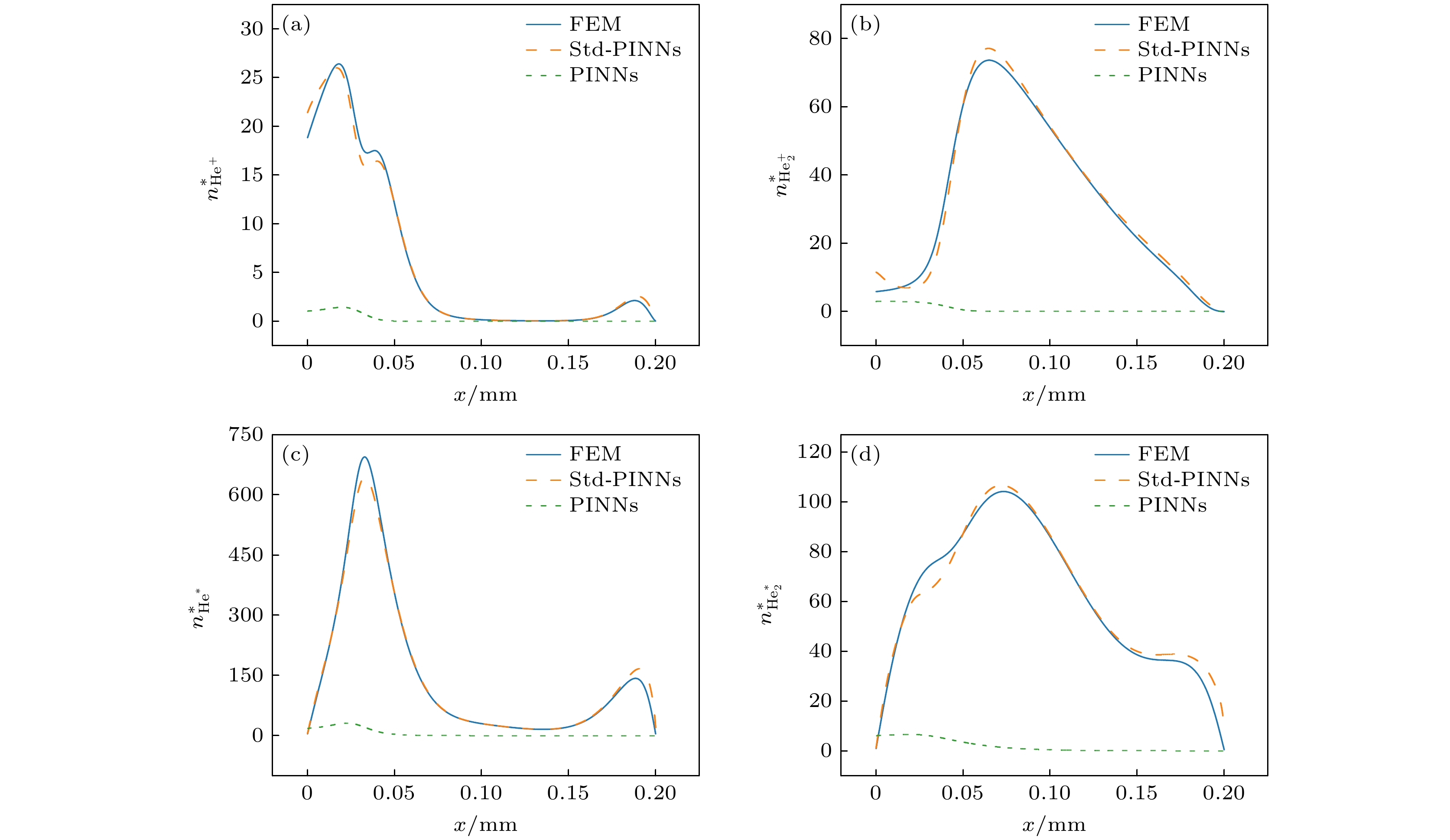-
In recent years, the artificial intelligence computing paradigm represented by physics-informed neural networks (PINNs) has received great attention in the field of plasma numerical simulation. However, the plasma chemical system considered in related research is relatively simplified, and the research on solving the more complex multi-particle low-temperature fluid model based on PINNs is still blank. In more complex chemical systems, the coupling relationship between particle densities and between particle densities and mean electron energy become more intricate. Therefore, the applicability of PINNs in dealing with sophisticated reaction systems needs further exploring and improving. In this work, we propose a general PINN framework (source term decoupled PINNs, Std-PINNs) for solving multi-particle low-temperature plasma fluid model. By introducing equivalent positive ions and replacing each particle transport equation with the current continuity equation as a physical constraint, Std-PINN splits the entire solution process into the training processes of two neural networks, realizing the decoupling of the source term of the heavy particle transport equation from the electron density and mean electron energy, which greatly reduces the complexity of neural network training. In this work, the application of Std-PINNs to solving multi-particle low-temperature plasma fluid models is demonstrated through two classic discharge cases with different complexity of reaction systems (low-pressure argon glow discharge and atmospheric-pressure helium glow discharge) and the performance of Std-PINN is compared with that of conventional PINN and finite element method (FEM). The results show that the training results output from the traditional PINN are completely incorrect due to the strong coupling correlation of each physical variable through the source terms of each particle transport equation, while the L2 relative error between Std-PINN and FEM results can reach up to ~10–2 , thus verifying the feasibility of Std-PINN in simulating multi-particle plasma fluid model. Std-PINN expands the application of deep learning method to modeling complex physical systems and provides new ideas for conducting low-temperature plasma simulations. In addition, this study provides novel insights into the field of artificial intelligence scientific computing: the mathematical form that describes the state of a physical system is not unique. By introducing equivalent physical variables, equations suitable for neural network solutions can be derived and combined with observable data to simplify problems.
-
Keywords:
- physics-informed neural networks /
- low-temperature plasma /
- source term decoupled /
- fluid model
[1] Sanito R C, You S J, Wang Y F 2021 J. Environ. Manage. 288 112380
 Google Scholar
Google Scholar
[2] Cheng H, Xu J X, Li X, Liu D W, Lu X P 2020 Phys. Plasmas 27 063514
 Google Scholar
Google Scholar
[3] Han Z J, Murdock A T, Seo D H, Bendavid A 2018 2D Mater. 5 032002
 Google Scholar
Google Scholar
[4] Lazarou C, Belmonte T, Chiper A S, Georghiou G E 2016 Plasma Sources Sci. Technol. 25 055023
 Google Scholar
Google Scholar
[5] Guikema J, Miller N, Niehof J, Klein M, Walhout M 2000 Phys. Rev. Lett. 85 3817
 Google Scholar
Google Scholar
[6] Fang Z, Wang X J, Shao T, Zhang C 2017 IEEE Trans. Plasma Sci. 45 310
 Google Scholar
Google Scholar
[7] Trelles J P 2016 J. Phys. D: Appl. Phys. 49 393002
 Google Scholar
Google Scholar
[8] Purwins H G 2011 IEEE Trans. Plasma Sci. 39 2112
 Google Scholar
Google Scholar
[9] Zhang Y H, Ning W J, Dai D, Wang Q 2019 Plasma Sci. Technol. 21 074003
 Google Scholar
Google Scholar
[10] Wang Q, Zhou X Y, Dai D, Huang Z E, Zhang D M 2021 Plasma Sources Sci. Technol. 30 05LT01
 Google Scholar
Google Scholar
[11] Wang Q, Ning W J, Dai D, Zhang Y H 2020 Plasma Process. Polym. 17 e1900182
 Google Scholar
Google Scholar
[12] Zhang Y H, Ning W J, Dai D, Wang Q 2019 Plasma Sources Sci. Technol. 28 104001
 Google Scholar
Google Scholar
[13] Biel W, Albanese R, Ambrosino R, et al. 2019 Fus. Eng. Des. 146 465
 Google Scholar
Google Scholar
[14] Logg A 2007 Archives of Computational Methods in Engineering (Vol.14) (Berlin: Springer) pp93–138
 Google Scholar
Google Scholar
[15] Eymard R, Gallouët T, Herbin R 2000 Handbook of Numerical Analysis (Vol. 7) (Amsterdam: Elsevier) pp713– 1018
 Google Scholar
Google Scholar
[16] Bogaerts A, Tu X, Whitehead J C, Centi G, Lefferts L, Guaitella O, Azzolina-Jury F, Kim H H, Murphy A B, Schneider W F 2020 J. Phys. D: Appl. Phys. 53 443001
 Google Scholar
Google Scholar
[17] Neyts E C 2016 Plasma Chem. Plasma Process. 36 185
 Google Scholar
Google Scholar
[18] Mei D H, Zhu X B, Wu C F, Ashford B, Williams P T, Tu X 2016 Appl. Catal. B 182 525
 Google Scholar
Google Scholar
[19] Yi Y H, Li S K, Cui Z L, Hao Y Z, Zhang Y, Wang L, Liu P, Tu X, Xu X M, Guo H C, Bogaerts A 2021 Appl. Catal. B 296 120384
 Google Scholar
Google Scholar
[20] Raissi M, Perdikaris P, Karniadakis G E 2019 J. Comput. Phys. 378 686
 Google Scholar
Google Scholar
[21] Raissi M, Yazdani A, Karniadakis G E 2020 Science 367 1026
 Google Scholar
Google Scholar
[22] De Florio M, Schiassi E, Ganapol B D, Furfaro R 2021 Phys. Fluids 33 047110
 Google Scholar
Google Scholar
[23] Arzani A, Wang J X, D’Souza R M 2021 Phys. Fluids 33 071905
 Google Scholar
Google Scholar
[24] Kawaguchi S, Takahashi K, Ohkama H, Satoh K 2020 Plasma Sources Sci. Technol. 29 025021
 Google Scholar
Google Scholar
[25] Cai S Z, Wang Z C, Wang S F, Perdikaris P, Karniadakis G E 2021 J. Heat Transfer 143 102719
 Google Scholar
Google Scholar
[26] Laubscher R 2021 Phys. Fluids 33 087101
 Google Scholar
Google Scholar
[27] Mathews A, Francisquez M, Hughes J W, Hatch D R, Zhu B, Rogers B N 2021 Phys. Rev. E 104 025205
 Google Scholar
Google Scholar
[28] Zhong L L, Gu Q, Wu B Y 2020 Comput. Phys. Commun. 257 107496
 Google Scholar
Google Scholar
[29] Zhong L L, Wu B Y, Wang Y 2022 Phys. Fluids 34 087116
 Google Scholar
Google Scholar
[30] Wan J, Wang Q, Dai D, Ning W J 2019 Phys. Plasmas 26 103510
 Google Scholar
Google Scholar
[31] Wang Q, Ning W J, Dai D, Zhang Y H, Ouyang J 2019 J. Phys. D: Appl. Phys. 52 205201
 Google Scholar
Google Scholar
[32] Glorot X, Bengio Y 2010 Proceedings of the 13th International Conference on Artificial Intelligence and Statistics Sardinia, Italy, May 13–15, 2010 pp249–256
[33] Liu D C, Nocedal J 1989 Math. Program. 45 503
 Google Scholar
Google Scholar
[34] Kingma D P, Ba J L 2014 arXiv: 1412.6980 [cs. LG]
[35] Wang S, Yu X, Perdikaris P 2022 J. Comput. Phys. 449 110768
 Google Scholar
Google Scholar
[36] Hagelaar G J M, Kroesen G M W 2000 J. Comput. Phys. 159 1
 Google Scholar
Google Scholar
[37] Blickle V, Speck T, Lutz C, Seifert U, Bechinger C 2007 Phys. Rev. Lett. 98 210601
 Google Scholar
Google Scholar
[38] Hagelaar G J M, Pitchford L C 2005 Plasma Sources Sci. Technol. 14 722
 Google Scholar
Google Scholar
[39] Wang Q, Economou D J, Donnelly V M 2006 J. Appl. Phys. 100 023301
 Google Scholar
Google Scholar
[40] Dyatko N A, Ionikh Y Z, Kochetov I V, Marinov D L, Meshchanov A V, Napartovich A P, Petrov F B, Starostin S A 2008 J. Phys. D: Appl. Phys. 41 055204
 Google Scholar
Google Scholar
[41] Deloche R, Monchicourt P, Cheret M, Lambert F 1976 Phys. Rev. A 13 1140
 Google Scholar
Google Scholar
[42] Hagelaar G J M, De Hoog F J, Kroesen G M W 2000 Phys. Rev. E 62 1452
 Google Scholar
Google Scholar
[43] Hassé H R, Cook W R 1931 Philos. Mag. J. Sci. 12 554
 Google Scholar
Google Scholar
[44] Staack D, Farouk B, Gutsol A, Fridman A 2005 Plasma Sources Sci. Technol. 14 700
 Google Scholar
Google Scholar
[45] Wang Q, Dai D, Ning W J, Zhang Y H 2021 J. Phys. D: Appl. Phys. 54 115203
 Google Scholar
Google Scholar
[46] Tochikubo F, Shirai N, Uchida S 2011 Appl. Phys. Express 4 056001
 Google Scholar
Google Scholar
[47] Zhang Y H, Ning W J, Dai D, Wang Q 2019 Plasma Sources Sci. Technol. 28 075003
 Google Scholar
Google Scholar
[48] Pitchford L C, Alves L L, Bartschat K, et al. 2017 Plasma Process. Polym. 14 1600098
 Google Scholar
Google Scholar
[49] Zhu X M, Pu Y K 2009 J. Phys. D: Appl. Phys. 43 015204
 Google Scholar
Google Scholar
[50] Riccardi C, Barni R 2012 Chem. Kinet. 10 38396
 Google Scholar
Google Scholar
[51] Liu D X, Iza F, Wang X H, Ma Z Z, Rong M Z, Kong M G 2013 Plasma Sources Sci. Technol. 22 055016
 Google Scholar
Google Scholar
[52] Zhu M R, Zhong A, Dai D, Wang Q, Shao T, Ostrikov K K 2022 J. Phys. D: Appl. Phys. 55 355201
 Google Scholar
Google Scholar
[53] Pietanza L D, Guaitella O, Aquilanti V, et al 2021 Eur. Phys. J. D 75 237
 Google Scholar
Google Scholar
-
表 A1 各案例基准值
Table A1. Reference values for each case.
案例 ${n_0}$/m–3 ${\phi _0}$/V ${\bar \varepsilon _0}$/eV ${L_0}$/m 1 1×1013 1×103 1 1×10–2 2 5×1017 1×103 1 1×10–4 表 1 低气压氩气辉光放电的碰撞反应
Table 1. Collision reaction of low pressure argon glow discharge.
序号 反应方程 速率常数 焓/eV 参考文献 1 e + Ar $\Rightarrow $ e + Ar f ($ \overline{\boldsymbol{\varepsilon}} $) — [48] 2 e + Ar $\Rightarrow $ e + Ar* f ($ \overline{\boldsymbol{\varepsilon}} $) 11.5 [48] 3 e + Ar $\Rightarrow $ 2e + Ar+ f ($ \overline{\boldsymbol{\varepsilon}} $) 15.8 [48] 4 e + Ar* $\Rightarrow $ 2e + Ar+ f ($ \overline{\boldsymbol{\varepsilon}} $) 4.43 [48] 5 Ar* + Ar* $\Rightarrow $ e + Ar+ Ar+ 6.2×10–16 — [40] 6 Ar* + Ar $\Rightarrow $ Ar+ Ar 3×10–21 — [40] 注: 表中f($ \overline{\boldsymbol{\varepsilon}} $)代表电子碰撞反应的速率常数, 为平均电子能的函数, 通过向Bolsig+导入电子碰撞反应截面数据计算得到; 双体反应的速率常数单位为m3/s. 表 2 大气压氦气辉光放电的碰撞反应
Table 2. Collision reaction of atmospheric pressure helium glow discharge.
序号 反应方程 速率常数 焓/eV 参考文献 1 e + He $\Rightarrow $ e + He f ($ \overline{\boldsymbol{\varepsilon}} $) — [48] 2 e + He $\Rightarrow $ e + He* f ($ \overline{\boldsymbol{\varepsilon}} $) 19.8 [48] 3 e + He $\Rightarrow $ 2e + He+ f ($ \overline{\boldsymbol{\varepsilon}} $) 24.6 [48] 4 e + He* $\Rightarrow $ 2e + He+ $1.28 \times 10^{-13}\times T_{\rm e}^{0.6}\times \exp(-4.78/T_{\rm e}) $ 4.8 [41] 5 e + He* $\Rightarrow $ e + He 2.9 × 10–15 –19.8 [41] 6 e + ${\mathrm{He}}_2^* $ $\Rightarrow $ e + 2He 3.8 × 10–15 –17.9 [39] 7 2e + He+ $\Rightarrow $ e + He* 6.0 × 10–32 × (Te/0.026)–4.4 –4.8 [4] 8 2e + ${\mathrm{He}}_2^+ $ $\Rightarrow $ e + He + He* 4.0 × 10–32 × (Te/0.026)–1 — [39] 9 e + He+ ${\mathrm{He}}_2^+ $ $\Rightarrow $2He + He* 5 × 10–39 × (Te/0.026)–1 — [39] 10 2e + ${\mathrm{He}}_2^+ $ $\Rightarrow $ e + ${\mathrm{He}}_2^* $ 4.0 × 10–32 × (Te/0.026)–1 — [39] 11 e + He+ He+ $\Rightarrow $ He + He* 5.0 × 10–39 × (Te/0.026)–1 — [39] 12 e + He+ ${\mathrm{He}}_2^+ $ $\Rightarrow $ He + ${\mathrm{He}}_2^* $ 1.0 × 10–38 × (Te/0.026)–2 — [39] 13 e + ${\mathrm{He}}_2^* $ $\Rightarrow $ 2e + ${\mathrm{He}}_2^+ $ 5.0 × 10–15 × (Te/0.026)–1 3.4 [39] 14 He* + 2He $\Rightarrow $ 3He 2.0 × 10–46 — [39] 15 2He* $\Rightarrow $ e + ${\mathrm{He}}_2^+ $ 2.9 × 10–15 — [39] 16 2He + He+ $\Rightarrow $ He + ${\mathrm{He}}_2^+ $ 1.4 × 10–43 — [4] 17 2He + He* $\Rightarrow $ ${\mathrm{He}}_2^* $ + He 2 × 10–46 — [4] 18 He* + ${\mathrm{He}}_2^* $ $\Rightarrow $ e + ${\mathrm{He}}_2^+ $ + He 5 × 10–16 — [4] 19 ${\mathrm{He}}_2^* $ + ${\mathrm{He}}_2^* $ $\Rightarrow $ e + ${\mathrm{He}}_2^+ $ + 2He 1.2 × 10–15 — [4] 20 ${\mathrm{He}}_2^* $ + He $\Rightarrow $ 3He 1.5 × 10–21 — [4] 注: 表中He*代表He(23S)及He(21S), He2*则代表He2(${\rm a}{}^3\Sigma_{\rm u}^+ $) . -
[1] Sanito R C, You S J, Wang Y F 2021 J. Environ. Manage. 288 112380
 Google Scholar
Google Scholar
[2] Cheng H, Xu J X, Li X, Liu D W, Lu X P 2020 Phys. Plasmas 27 063514
 Google Scholar
Google Scholar
[3] Han Z J, Murdock A T, Seo D H, Bendavid A 2018 2D Mater. 5 032002
 Google Scholar
Google Scholar
[4] Lazarou C, Belmonte T, Chiper A S, Georghiou G E 2016 Plasma Sources Sci. Technol. 25 055023
 Google Scholar
Google Scholar
[5] Guikema J, Miller N, Niehof J, Klein M, Walhout M 2000 Phys. Rev. Lett. 85 3817
 Google Scholar
Google Scholar
[6] Fang Z, Wang X J, Shao T, Zhang C 2017 IEEE Trans. Plasma Sci. 45 310
 Google Scholar
Google Scholar
[7] Trelles J P 2016 J. Phys. D: Appl. Phys. 49 393002
 Google Scholar
Google Scholar
[8] Purwins H G 2011 IEEE Trans. Plasma Sci. 39 2112
 Google Scholar
Google Scholar
[9] Zhang Y H, Ning W J, Dai D, Wang Q 2019 Plasma Sci. Technol. 21 074003
 Google Scholar
Google Scholar
[10] Wang Q, Zhou X Y, Dai D, Huang Z E, Zhang D M 2021 Plasma Sources Sci. Technol. 30 05LT01
 Google Scholar
Google Scholar
[11] Wang Q, Ning W J, Dai D, Zhang Y H 2020 Plasma Process. Polym. 17 e1900182
 Google Scholar
Google Scholar
[12] Zhang Y H, Ning W J, Dai D, Wang Q 2019 Plasma Sources Sci. Technol. 28 104001
 Google Scholar
Google Scholar
[13] Biel W, Albanese R, Ambrosino R, et al. 2019 Fus. Eng. Des. 146 465
 Google Scholar
Google Scholar
[14] Logg A 2007 Archives of Computational Methods in Engineering (Vol.14) (Berlin: Springer) pp93–138
 Google Scholar
Google Scholar
[15] Eymard R, Gallouët T, Herbin R 2000 Handbook of Numerical Analysis (Vol. 7) (Amsterdam: Elsevier) pp713– 1018
 Google Scholar
Google Scholar
[16] Bogaerts A, Tu X, Whitehead J C, Centi G, Lefferts L, Guaitella O, Azzolina-Jury F, Kim H H, Murphy A B, Schneider W F 2020 J. Phys. D: Appl. Phys. 53 443001
 Google Scholar
Google Scholar
[17] Neyts E C 2016 Plasma Chem. Plasma Process. 36 185
 Google Scholar
Google Scholar
[18] Mei D H, Zhu X B, Wu C F, Ashford B, Williams P T, Tu X 2016 Appl. Catal. B 182 525
 Google Scholar
Google Scholar
[19] Yi Y H, Li S K, Cui Z L, Hao Y Z, Zhang Y, Wang L, Liu P, Tu X, Xu X M, Guo H C, Bogaerts A 2021 Appl. Catal. B 296 120384
 Google Scholar
Google Scholar
[20] Raissi M, Perdikaris P, Karniadakis G E 2019 J. Comput. Phys. 378 686
 Google Scholar
Google Scholar
[21] Raissi M, Yazdani A, Karniadakis G E 2020 Science 367 1026
 Google Scholar
Google Scholar
[22] De Florio M, Schiassi E, Ganapol B D, Furfaro R 2021 Phys. Fluids 33 047110
 Google Scholar
Google Scholar
[23] Arzani A, Wang J X, D’Souza R M 2021 Phys. Fluids 33 071905
 Google Scholar
Google Scholar
[24] Kawaguchi S, Takahashi K, Ohkama H, Satoh K 2020 Plasma Sources Sci. Technol. 29 025021
 Google Scholar
Google Scholar
[25] Cai S Z, Wang Z C, Wang S F, Perdikaris P, Karniadakis G E 2021 J. Heat Transfer 143 102719
 Google Scholar
Google Scholar
[26] Laubscher R 2021 Phys. Fluids 33 087101
 Google Scholar
Google Scholar
[27] Mathews A, Francisquez M, Hughes J W, Hatch D R, Zhu B, Rogers B N 2021 Phys. Rev. E 104 025205
 Google Scholar
Google Scholar
[28] Zhong L L, Gu Q, Wu B Y 2020 Comput. Phys. Commun. 257 107496
 Google Scholar
Google Scholar
[29] Zhong L L, Wu B Y, Wang Y 2022 Phys. Fluids 34 087116
 Google Scholar
Google Scholar
[30] Wan J, Wang Q, Dai D, Ning W J 2019 Phys. Plasmas 26 103510
 Google Scholar
Google Scholar
[31] Wang Q, Ning W J, Dai D, Zhang Y H, Ouyang J 2019 J. Phys. D: Appl. Phys. 52 205201
 Google Scholar
Google Scholar
[32] Glorot X, Bengio Y 2010 Proceedings of the 13th International Conference on Artificial Intelligence and Statistics Sardinia, Italy, May 13–15, 2010 pp249–256
[33] Liu D C, Nocedal J 1989 Math. Program. 45 503
 Google Scholar
Google Scholar
[34] Kingma D P, Ba J L 2014 arXiv: 1412.6980 [cs. LG]
[35] Wang S, Yu X, Perdikaris P 2022 J. Comput. Phys. 449 110768
 Google Scholar
Google Scholar
[36] Hagelaar G J M, Kroesen G M W 2000 J. Comput. Phys. 159 1
 Google Scholar
Google Scholar
[37] Blickle V, Speck T, Lutz C, Seifert U, Bechinger C 2007 Phys. Rev. Lett. 98 210601
 Google Scholar
Google Scholar
[38] Hagelaar G J M, Pitchford L C 2005 Plasma Sources Sci. Technol. 14 722
 Google Scholar
Google Scholar
[39] Wang Q, Economou D J, Donnelly V M 2006 J. Appl. Phys. 100 023301
 Google Scholar
Google Scholar
[40] Dyatko N A, Ionikh Y Z, Kochetov I V, Marinov D L, Meshchanov A V, Napartovich A P, Petrov F B, Starostin S A 2008 J. Phys. D: Appl. Phys. 41 055204
 Google Scholar
Google Scholar
[41] Deloche R, Monchicourt P, Cheret M, Lambert F 1976 Phys. Rev. A 13 1140
 Google Scholar
Google Scholar
[42] Hagelaar G J M, De Hoog F J, Kroesen G M W 2000 Phys. Rev. E 62 1452
 Google Scholar
Google Scholar
[43] Hassé H R, Cook W R 1931 Philos. Mag. J. Sci. 12 554
 Google Scholar
Google Scholar
[44] Staack D, Farouk B, Gutsol A, Fridman A 2005 Plasma Sources Sci. Technol. 14 700
 Google Scholar
Google Scholar
[45] Wang Q, Dai D, Ning W J, Zhang Y H 2021 J. Phys. D: Appl. Phys. 54 115203
 Google Scholar
Google Scholar
[46] Tochikubo F, Shirai N, Uchida S 2011 Appl. Phys. Express 4 056001
 Google Scholar
Google Scholar
[47] Zhang Y H, Ning W J, Dai D, Wang Q 2019 Plasma Sources Sci. Technol. 28 075003
 Google Scholar
Google Scholar
[48] Pitchford L C, Alves L L, Bartschat K, et al. 2017 Plasma Process. Polym. 14 1600098
 Google Scholar
Google Scholar
[49] Zhu X M, Pu Y K 2009 J. Phys. D: Appl. Phys. 43 015204
 Google Scholar
Google Scholar
[50] Riccardi C, Barni R 2012 Chem. Kinet. 10 38396
 Google Scholar
Google Scholar
[51] Liu D X, Iza F, Wang X H, Ma Z Z, Rong M Z, Kong M G 2013 Plasma Sources Sci. Technol. 22 055016
 Google Scholar
Google Scholar
[52] Zhu M R, Zhong A, Dai D, Wang Q, Shao T, Ostrikov K K 2022 J. Phys. D: Appl. Phys. 55 355201
 Google Scholar
Google Scholar
[53] Pietanza L D, Guaitella O, Aquilanti V, et al 2021 Eur. Phys. J. D 75 237
 Google Scholar
Google Scholar
Catalog
Metrics
- Abstract views: 6231
- PDF Downloads: 116
- Cited By: 0














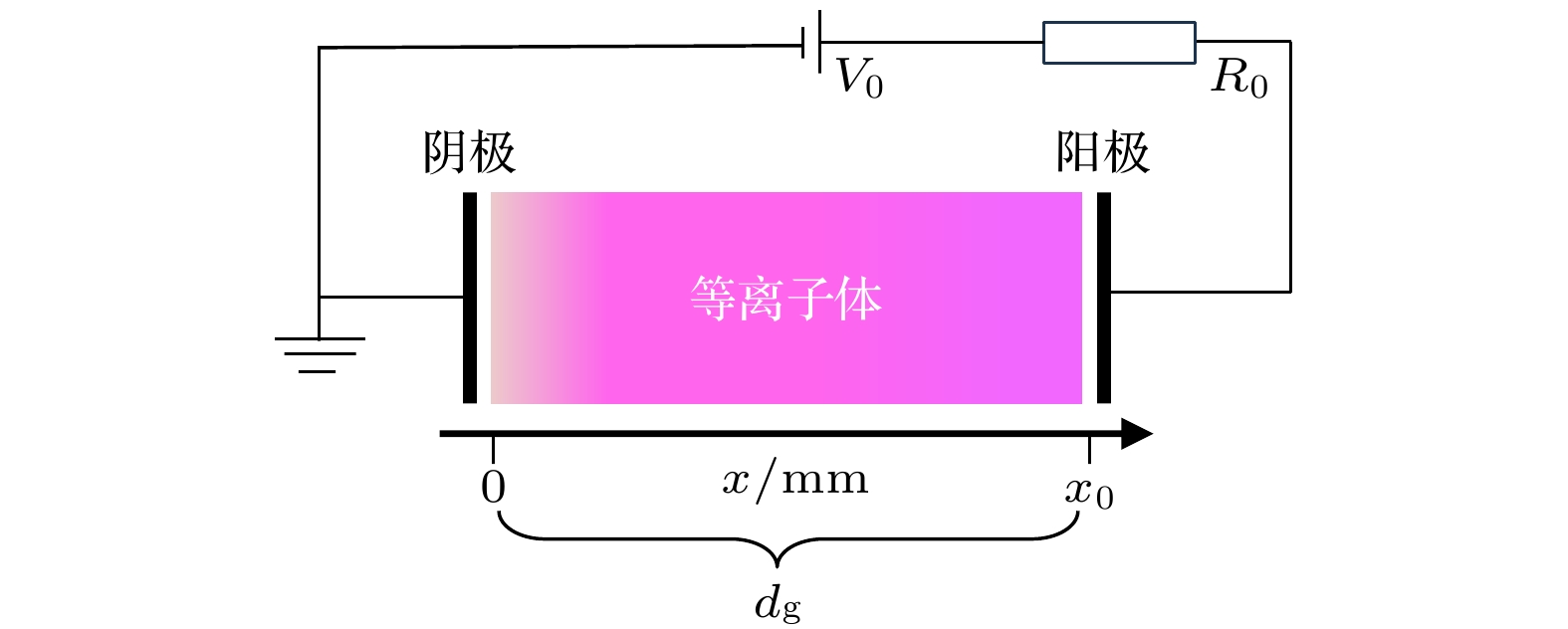
 DownLoad:
DownLoad:


